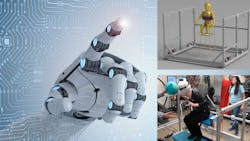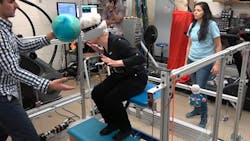About 17,000 people in the U.S. injure their spinal cords each year, and most survive. But many are paralyzed and confined to wheelchairs—and this can prove to be a physical challenge in its own right. To help these individuals regain control of their torso and sit more stably, biomedical engineers at Columbia University have developed a robotic device they dubbed the Trunk-Support Trainer (TruST). It can assist and retrain the muscles and reflexes in people with damaged spinal cords to sit safely and comfortably without falling over or using their hands to balance.
TruST is a motorized-cable driven belt placed on the user’s torso to determine a patient’s posture control limits. It supplies forces on the torso when the user performs upper body movements beyond their limits while sitting.
In the initial evaluation of the device with five subjects who had spinal injuries, each went through the Postural Star-Sitting Test. It required each to follow a ball with their head and move their trunk as far as possible without using their hands. The test was repeated in eight directions. Researchers used the results to compute each person’s sitting workspace.
The team then tailored the TruST for each subject to apply customized forces on their torso while they went through the same movements again. With the TruST, subjects could reach further during the trunk excursions in all eight directions by 25%.
“The capacity of TruST to deliver continuous force-feedback personalized for the user’s postural limits opens new frontiers to implement motor learning-based paradigms to retrain functional sitting in people with SCI,” says Victor Santamaria, a physical therapist and Columbia researcher. Patients often go through thousands of hours of rehab retraining muscles to do simple things such as walking. Using a robot cold lower the cost and make the training more consistent and useful.


